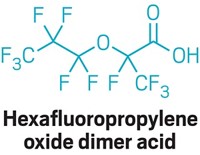Advertisement
Grab your lab coat. Let's get started
Welcome!
Welcome!
Create an account below to get 6 C&EN articles per month, receive newsletters and more - all free.
It seems this is your first time logging in online. Please enter the following information to continue.
As an ACS member you automatically get access to this site. All we need is few more details to create your reading experience.
Not you? Sign in with a different account.
Not you? Sign in with a different account.
ERROR 1
ERROR 1
ERROR 2
ERROR 2
ERROR 2
ERROR 2
ERROR 2
Password and Confirm password must match.
If you have an ACS member number, please enter it here so we can link this account to your membership. (optional)
ERROR 2
ACS values your privacy. By submitting your information, you are gaining access to C&EN and subscribing to our weekly newsletter. We use the information you provide to make your reading experience better, and we will never sell your data to third party members.
Environment
Restricting Dioxin In Dirt
Environment: EPA proposes to strengthen cleanup guidelines
by Cheryl Hogue
January 11, 2010
| A version of this story appeared in
Volume 88, Issue 2

In a move that could portend more extensive and expensive cleanups, EPA is proposing to tighten its guidelines for remediating polychlorinated dioxins in soils.
EPA proposes what it calls "preliminary remediation goals" of 72 parts per trillion of dioxin in residential soil and 950 ppt for commercial or industrial land. EPA defines these goals as "national levels protective for cancer and non-cancer effects from human exposure by ingestion and dermal contact with surface soils."
The proposed levels would be significantly lower than EPA's current preliminary remediation goals, set in 1998. Those are 1,000 ppt for dioxin in residential soil and a range of 5,000–20,000 ppt in commercial or industrial soil.
Once finalized, EPA will ask its regional offices, states, and tribes to use the new goals, which are not legally binding, as starting points as they craft cleanup plans for dioxin-contaminated sites.
The proposed goals, which the agency released without fanfare on Dec. 31, 2009, take into consideration the potential for absorption of dioxin through skin in contact with contaminated soil, EPA says.
"We are following through on our commitment to use the best available science to help protect human health and the environment," says Mathy Stanislaus, assistant administrator for EPA's Office of Solid Waste & Emergency Response.
Environmental groups praised EPA's move, saying it will lead to better protection of the public and the environment.
But some in industry think the agency is taking the wrong approach.
"Soils aren't really a primary route of exposure" for dioxin, says Mary Draves, a spokeswoman for Dow Chemical. She pointed to a study by the University of Michigan -- which EPA recently dismissed as "of limited value" -- that found living on dioxin-contaminated soil does not contribute to the levels of dioxins in people's blood (C&EN, Oct. 12, page 36).
Draves tells C&EN that current remediation goals are already protective of health.
Dow is facing cleanup of dioxin in two rivers downstream of its Midland, Mich., plant, as well as Saginaw Bay in Lake Huron (C&EN, Aug. 11, 2008, page 32). The contamination stemmed from the chemical maker's past operations. Since striking a deal late last year, Dow and EPA have been working together to investigate the extent of the pollution and craft a long-term cleanup plan.
Draves says Dow can't speculate how the EPA proposal might affect future cleanup.
The American Chemistry Council, a trade association of chemical manufacturers, criticized the proposal, saying it is unclear why EPA proposed the new cleanup goals before the agency has finished its comprehensive reassessment of dioxins.
"EPA should first complete its dioxin reassessment and then evaluate the protectiveness of current [goals] for dioxin in soil against current science as well as public health priorities," says Robert Simon, ACC's vice president for chemical products and technology.
EPA says the newly proposed preliminary remediation goals, which it intends to finalize by mid-year, would be an interim measure until it finishes reassessing health and environmental risks posed by dioxins. Agency Administrator Lisa P. Jackson has set a deadline for the end of 2010 for that reassessment, which has been churning unfinished in the agency for nearly 20 years.





Join the conversation
Contact the reporter
Submit a Letter to the Editor for publication
Engage with us on Twitter